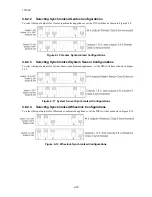
HPF902ULADA Distributed Power Module Installation Manual
4-5
Section 4
Installation
Before installing the HPF902ULADA, the AC input must first be wired into the building’s main electrical power
through the TB1 terminals (see Figure 4-2). Shut off the electrical power to the HPF902ULADA, and then
complete the general installation of the HPF902ULADA using the information in this section.
4.1
Mounting
Mount the HPF902ULADA in locations that meet the following temperature and humidity requirements. Do not
expose the panel to conditions outside these ranges. For use in indoor, dry environments.
When mounting on interior walls, use appropriate screw anchors in plaster. When mounting on concrete,
especially when moisture is expected, first attach a piece of 3/4-inch plywood to the concrete surface. Attach the
HPF902ULADA to the plywood.
4.1.1
Preventing Water Damage
Water damage to the fire system can be caused by moisture entering the cabinet through the conduits. Conduits
that are installed to enter the top of the cabinet are most likely to cause water problems. Installers should take
reasonable precautions to prevent water from entering the cabinet. Water damage is not covered under warranty.
4.2
Wire Routing
To avoid induced noise (transfer of electrical energy from one wire to another), keep input wiring isolated from
high current output and power-limited wiring. Induced noise can interfere with telephone communication or even
cause false alarms. Avoid pulling a single multiconductor cable for the entire system. Instead, separate high
current input/output from low current. Separate power-limited from non-power-limited wiring.
Non-power-limited wiring must be enclosed in conduit.
Wiring within the cabinet should be routed around the perimeter of the cabinet. It should not cross the printed
circuit board where it could induce noise into the sensitive microelectronics or pick up unwanted RF noise from
Temperature
0
o
C-49
o
C (32
o
F-120
o
F)
Humidity
10%-93% at 30
o
C (86
o
F) noncondensing










































